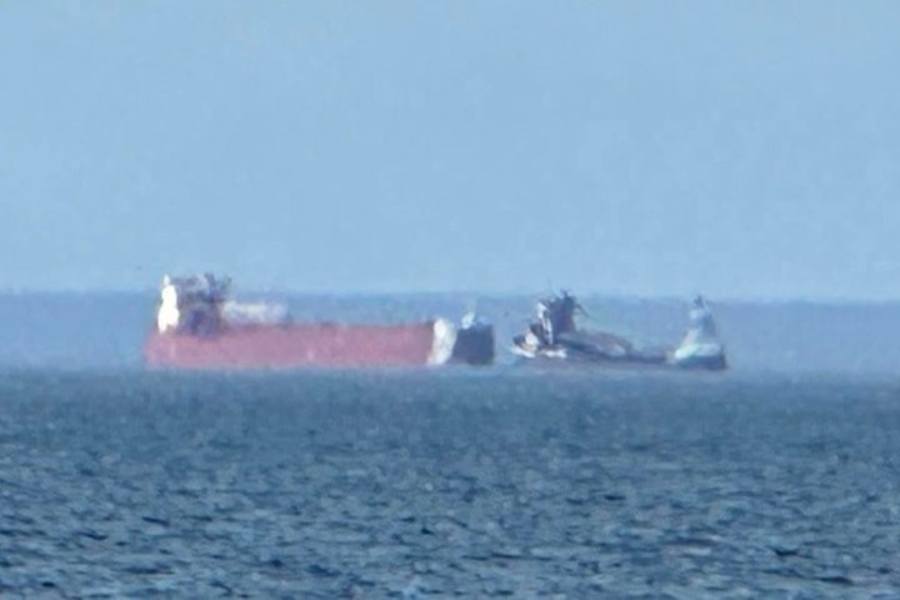
Early on a brisk Saturday morning, the tranquility of Lake Superior was disrupted when the Michipicoten, a 689-foot freighter, encountered an unexpected underwater hazard. This incident, approximately 35 miles southwest of Isle Royale—a remote part of Michigan—prompted a full-scale emergency response spearheaded by the U.S. Coast Guard.
The freighter, heavily laden with taconite, a type of iron ore among the region’s most common cargoes, navigated through one of the lake’s most trafficked routes when disaster struck. At around 6:53 a.m., the crew reported a collision with an unidentified object submerged beneath the lake’s surface, which immediately compromised the vessel’s integrity.
As water began infiltrating the hull, the situation aboard the Michipicoten quickly escalated from routine to critical. The ship’s built-in pumps were activated immediately, working tirelessly to expel the incoming water. Despite these efforts, the vessel developed a significant list, initially tilting 15 degrees to the side, a stark indicator of the severity of the breach.
The Coast Guard’s Great Lakes District was swift to react. Deploying from stations across the northern expanse of the lake, they coordinated an intricate rescue and stabilization operation. By 9:15 a.m., the effectiveness of the response was evident: the list had been corrected to a more manageable 5 degrees, significantly reducing the risk of capsizing.
Simultaneously, the decision was made to evacuate half of the 22-person crew. This precautionary measure, executed precisely by Coast Guard personnel, ensured that all crew members were safely transported away from the potential peril. The evacuated crew members were taken aboard accompanying vessels, including the bulk carrier Edwin H. Gott, which provided crucial support during the operation.
Helicopters and additional boat crews were also dispatched to the scene, ensuring that every available resource was utilized in managing the crisis. The National Park Service and the Border Patrol lent their support, highlighting the collaborative effort required in such maritime emergencies.
Throughout the ordeal, environmental concerns were paramount. Lake Superior, known for its pristine conditions and ecological significance, is a vital resource for the surrounding communities and wildlife. The initial fears of a taconite spill were quickly allayed as the Coast Guard confirmed that no spillage had occurred, much to the relief of environmentalists and local authorities.
As the Michipicoten made its way to the safety of Thunder Bay for repairs, questions lingered about the nature of the object it had struck. While beautiful, Lake Superior is also a repository of numerous shipwrecks and submerged logs, which could pose a significant hazard to modern vessels.
The incident has reignited discussions about the safety measures and navigational technologies employed in the Great Lakes shipping lanes. Experts call for enhanced sonar capabilities and better underwater mapping of known problem areas to prevent future incidents. The investigation into what the Michipicoten struck continues, with the Coast Guard leading efforts to uncover the cause of the collision.
This event serves as a reminder of the inherent risks faced by those who navigate the vast waters of the Great Lakes. It also underscores the critical importance of prepared emergency response protocols, which in this case, undoubtedly prevented a bad situation from becoming a full-fledged disaster.
As the community reflects on the events, it recognizes the bravery and effectiveness of the Coast Guard and all the personnel involved. Their rapid response and expert management showcased a well-oiled machine operating at peak efficiency, ensuring that lives were saved and environmental harm was avoided.
Looking forward, the maritime community is focused on learning from this incident. The data gathered from the response efforts will be analyzed to refine further and enhance safety protocols. Additionally, this event will likely influence future ship design and emergency readiness policies, contributing to safer maritime operations across all the Great Lakes.
In the wake of the Michipicoten incident, there is a renewed commitment to safeguarding the lakes and ensuring the safety of those who brave their waters. The community, while shaken, remains grateful for the absence of serious injury or environmental damage and is more determined than ever to prevent such occurrences in the future.
As investigations continue and the Michipicoten undergoes repairs, the maritime world watches and learns, hoping to navigate safer through the unseen dangers beneath the surfaces of our great waters. This incident is not just a tale of what went wrong but a testament to what can go right when preparation meets opportunity, and dedicated professionals lead the way.








